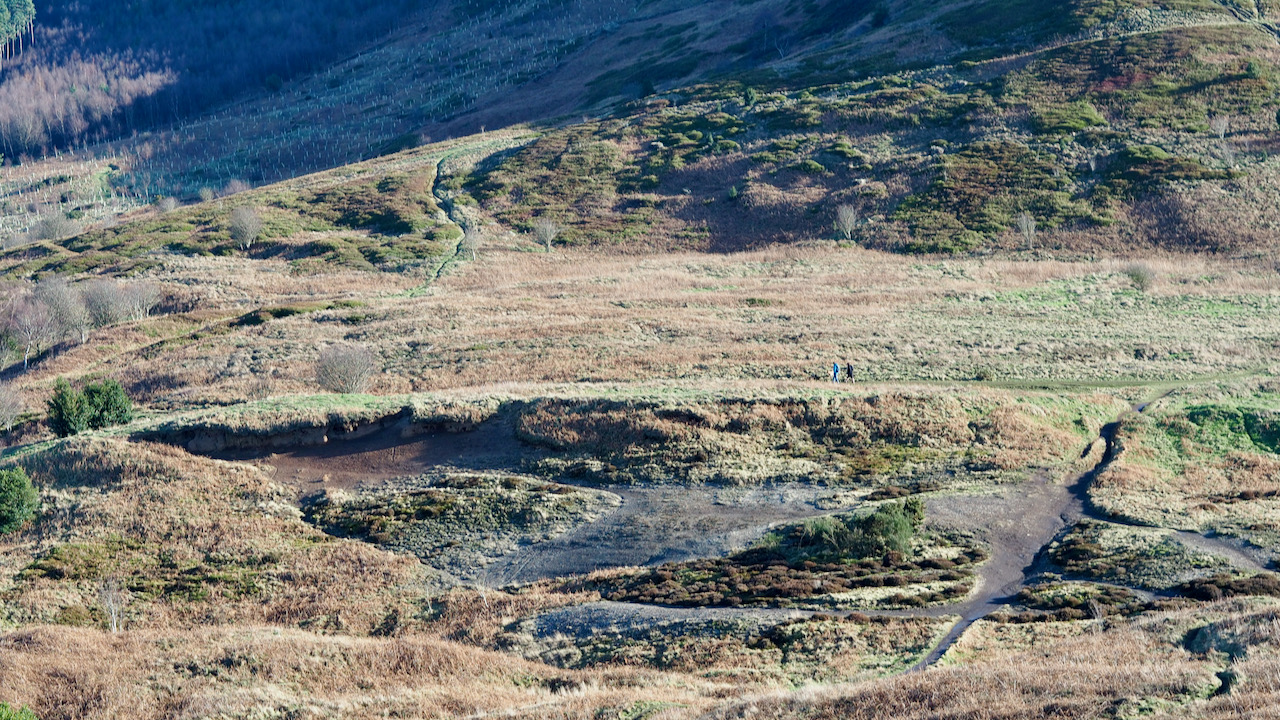A casual remark recently brought my attention to this stretch of barren spoil heaps nestled just beneath the col between Roseberry Topping and Little Roseberry.
This scarring owes its existence to the extraction of jet, a prized black rock revered for millennia, but especially gaining favour after Queen Victoria took to wearing it in mourning for her beloved Albert.
Traditionally, jet was found by tunnelling into hillsides, with the excavated soil meticulously sifted for its treasures. However, at this col, an open-cast method was employed, involving extensive excavation across a broad area1Jet workings at Roseberry Topping NYMNPA HER Record No: 78612Possibly jet working (RT56), Roseberry Common MNA193617 | National Trust Heritage Records Nationaltrust.org.uk 2015 URL: https://heritagerecords.nationaltrust.org.uk/HBSMR/MonRecord.aspx?uid=MNA193617[Accessed 7 Feb 24]3Earthworks possibly associated with jet extraction (RT55), Roseberry Common MNA193616 | National Trust Heritage Records Nationaltrust.org.uk Year: 2015 URL: https://heritagerecords.nationaltrust.org.uk/HBSMR/MonRecord.aspx?uid=MNA193616[Accessed 7 Feb 24].
The jet-bearing shales lie approximately 7 metres above the ironstone layer, which provides the foundation for the nearby summerhouse. Within this 9-metre band of oily shale lies the sought-after jet, originating from the fossilised driftwood of ancient monkey puzzle trees.
Moving upwards towards the summit, the succession of rocks includes many thinly bedded bitumen shales, culminating in alum shale, which demarcates the end of the lower Jurassic Period.
Alum shale, prized for centuries, has been quarried extensively in Yorkshire for various purposes, including dyeing, leather treatment, contraception, and dental applications. While several nearby regions saw exploitation of alum, the Roseberry area has fortunately remained untouched by such endeavours4“Roseberry Topping”. Great Ayton Community Archaeology Project. Page 118. 2006 ISBN 978-0-9554153-0-2..
- 1Jet workings at Roseberry Topping NYMNPA HER Record No: 7861
- 2Possibly jet working (RT56), Roseberry Common MNA193617 | National Trust Heritage Records Nationaltrust.org.uk 2015 URL: https://heritagerecords.nationaltrust.org.uk/HBSMR/MonRecord.aspx?uid=MNA193617[Accessed 7 Feb 24]
- 3Earthworks possibly associated with jet extraction (RT55), Roseberry Common MNA193616 | National Trust Heritage Records Nationaltrust.org.uk Year: 2015 URL: https://heritagerecords.nationaltrust.org.uk/HBSMR/MonRecord.aspx?uid=MNA193616[Accessed 7 Feb 24]
- 4“Roseberry Topping”. Great Ayton Community Archaeology Project. Page 118. 2006 ISBN 978-0-9554153-0-2.

Leave a Reply